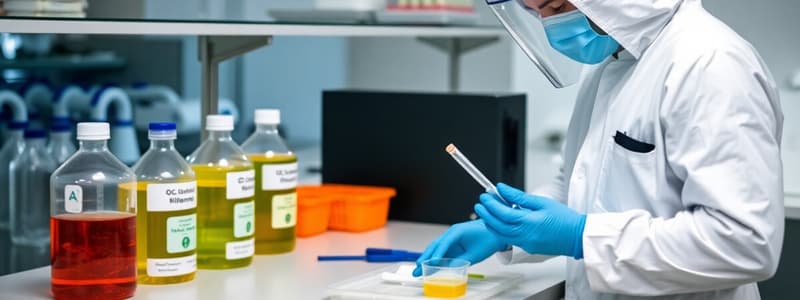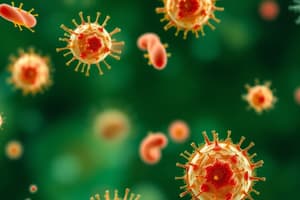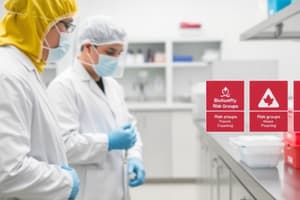Podcast
Questions and Answers
What is the highest risk group classification for pathogenic organisms?
What is the highest risk group classification for pathogenic organisms?
- Risk Group 2
- Risk Group 4 (correct)
- Risk Group 3
- Risk Group 1
Which biosafety level is most commonly operated by clinical laboratories?
Which biosafety level is most commonly operated by clinical laboratories?
- BSL-1
- BSL-2 (correct)
- BSL-3
- BSL-4
What distinguishes Risk Group 3 pathogens from those in Risk Group 2?
What distinguishes Risk Group 3 pathogens from those in Risk Group 2?
- No treatments are available for infections from Risk Group 3 pathogens.
- Risk Group 3 pathogens pose a negligible risk to laboratory workers.
- Risk Group 3 pathogens can cause serious illness but do not spread from person to person. (correct)
- Risk Group 3 pathogens can spread easily within the community.
Which of the following statements about Risk Group 1 pathogens is correct?
Which of the following statements about Risk Group 1 pathogens is correct?
What role does the ABSA International play in laboratory safety?
What role does the ABSA International play in laboratory safety?
Which statement accurately describes BSL-3 laboratories?
Which statement accurately describes BSL-3 laboratories?
Which risk group is characterized by pathogens that can cause serious infections but which effective treatments exist?
Which risk group is characterized by pathogens that can cause serious infections but which effective treatments exist?
What is an essential factor in determining the appropriate laboratory biosafety level?
What is an essential factor in determining the appropriate laboratory biosafety level?
Which factor does NOT influence the pathogenicity of an organism when classifying microorganisms by risk group?
Which factor does NOT influence the pathogenicity of an organism when classifying microorganisms by risk group?
What safety equipment is typically NOT worn in a BSL-2 clinical lab setting?
What safety equipment is typically NOT worn in a BSL-2 clinical lab setting?
What is the primary purpose of PPE according to the CDC/NIOSH Hierarchy of Safety Controls?
What is the primary purpose of PPE according to the CDC/NIOSH Hierarchy of Safety Controls?
In which scenario is enhanced precautionary PPE required in a BSL-2 setting?
In which scenario is enhanced precautionary PPE required in a BSL-2 setting?
Which of the following is NOT an example of effective treatment?
Which of the following is NOT an example of effective treatment?
Which risk group is associated with serious human or animal diseases and high transmissibility?
Which risk group is associated with serious human or animal diseases and high transmissibility?
Which of the following organisms would typically require BSL-3 practices when handled in a lab?
Which of the following organisms would typically require BSL-3 practices when handled in a lab?
In risk assessments, which factor is not considered when determining local preventive measures?
In risk assessments, which factor is not considered when determining local preventive measures?
Which biosafety level includes controlled access and special clothing requirements?
Which biosafety level includes controlled access and special clothing requirements?
Which of the following PPE is least likely used when extended or enhanced precautions are deemed necessary?
Which of the following PPE is least likely used when extended or enhanced precautions are deemed necessary?
Which treatment option is primarily used for immediate protection against exposure before the occurrence of an infection?
Which treatment option is primarily used for immediate protection against exposure before the occurrence of an infection?
In a BSL-4 lab, which of the following is very likely observed?
In a BSL-4 lab, which of the following is very likely observed?
When is it advisable to conduct a risk assessment in a laboratory?
When is it advisable to conduct a risk assessment in a laboratory?
Which statement about biosafety levels and risk groups is true?
Which statement about biosafety levels and risk groups is true?
Which type of glove should be used when handling chemicals with high acute toxicity?
Which type of glove should be used when handling chemicals with high acute toxicity?
What is NOT a recommended action for maintaining personal protective equipment (PPE)?
What is NOT a recommended action for maintaining personal protective equipment (PPE)?
Which section of the Safety Data Sheet provides information on how to minimize exposure to a chemical?
Which section of the Safety Data Sheet provides information on how to minimize exposure to a chemical?
What does the term 'flame resistant' refer to in lab coats?
What does the term 'flame resistant' refer to in lab coats?
What should be done immediately after using reusable PPE?
What should be done immediately after using reusable PPE?
Which of the following best describes bloodborne pathogens?
Which of the following best describes bloodborne pathogens?
When handling hazardous materials, which glove feature is NOT typically considered?
When handling hazardous materials, which glove feature is NOT typically considered?
Which of the following is included in the 16 sections of a Safety Data Sheet (SDS)?
Which of the following is included in the 16 sections of a Safety Data Sheet (SDS)?
What should a safety protocol include when working with bloodborne pathogens?
What should a safety protocol include when working with bloodborne pathogens?
Which option is considered a primary means of minimizing exposure to bloodborne pathogens?
Which option is considered a primary means of minimizing exposure to bloodborne pathogens?
What is one of the limitations of lab coat materials mentioned?
What is one of the limitations of lab coat materials mentioned?
Which hazard is NOT effectively covered by typical glove materials?
Which hazard is NOT effectively covered by typical glove materials?
What is the main purpose of using PPE in a laboratory setting?
What is the main purpose of using PPE in a laboratory setting?
Which of the following is a recommendation for the storage of PPE?
Which of the following is a recommendation for the storage of PPE?
What criteria is essential when conducting a lab hazard analysis?
What criteria is essential when conducting a lab hazard analysis?
Which type of eye protection is required when there is a high risk of chemical splash?
Which type of eye protection is required when there is a high risk of chemical splash?
What is a limitation of safety glasses in a laboratory environment?
What is a limitation of safety glasses in a laboratory environment?
When should a face shield be used in conjunction with other eye protection?
When should a face shield be used in conjunction with other eye protection?
In the context of PPE, how do contact lenses perform as a form of eye protection?
In the context of PPE, how do contact lenses perform as a form of eye protection?
Which of the following is NOT a mandatory minimum PPE requirement?
Which of the following is NOT a mandatory minimum PPE requirement?
What type of gloves are essential when working with hazardous substances?
What type of gloves are essential when working with hazardous substances?
What is the effectiveness of ordinary prescription glasses in laboratory safety?
What is the effectiveness of ordinary prescription glasses in laboratory safety?
Which engineering control is most effective to reduce inhalation exposure during lab activities?
Which engineering control is most effective to reduce inhalation exposure during lab activities?
What should be done if contact lenses become contaminated with a hazardous chemical?
What should be done if contact lenses become contaminated with a hazardous chemical?
What is the purpose of a lab coat in a laboratory setting?
What is the purpose of a lab coat in a laboratory setting?
Why is a medical questionnaire required for respirator users according to OSHA regulations?
Why is a medical questionnaire required for respirator users according to OSHA regulations?
Which type of lab coat should be selected to minimize the risk of fire hazards?
Which type of lab coat should be selected to minimize the risk of fire hazards?
When is it necessary to wear chemical splash goggles?
When is it necessary to wear chemical splash goggles?
Which of the following is NOT a component of the OSHA Bloodborne Pathogens Standard?
Which of the following is NOT a component of the OSHA Bloodborne Pathogens Standard?
What is the primary purpose of standard precautions in a healthcare setting?
What is the primary purpose of standard precautions in a healthcare setting?
Which of the following actions is considered a work practice control?
Which of the following actions is considered a work practice control?
What should be done if blood comes into contact with mucous membranes?
What should be done if blood comes into contact with mucous membranes?
Which of the following sharps should be handled with the utmost care?
Which of the following sharps should be handled with the utmost care?
What is one way to minimize the risk of exposure to bloodborne pathogens?
What is one way to minimize the risk of exposure to bloodborne pathogens?
What category does non-intact skin fall under in standard precautions?
What category does non-intact skin fall under in standard precautions?
What action is prohibited regarding sharps?
What action is prohibited regarding sharps?
Which of the following is a recommended engineering control?
Which of the following is a recommended engineering control?
How is parenteral exposure defined?
How is parenteral exposure defined?
Flashcards are hidden until you start studying
Study Notes
Risk Groups and Biosafety Levels
- Pathogenic organisms are classified into four risk groups based on their associated risk, with Risk Group 4 being the highest.
- Risk Group 1 organisms are unlikely to cause disease.
- Risk Group 2 organisms can cause disease but are unlikely to be a serious hazard.
- Risk Group 3 organisms usually cause serious disease but do not spread easily.
- Risk Group 4 organisms usually cause serious disease and can be readily transmitted.
- Laboratory facilities are designated as Biosafety Levels (BSL) 1 through 4 based on their containment features and practices.
- Most clinical laboratories operate at BSL-2, which requires basic safety precautions and standard PPE.
- BSL-3 laboratories are designed for higher-risk work, such as handling cultures of Mycobacterium tuberculosis.
PPE (Personnel Protection Equipment)
- It's essential to identify all hazards in the lab before selecting PPE.
- Mandatory minimum PPE for labs includes protective eyewear, a lab coat, closed-toed shoes, and chemical-resistant gloves when handling hazardous substances.
- Safety glasses with side shields are required when there's a possibility of objects striking the eye.
- Chemical splash goggles should be worn when there's a high potential for splash from hazardous material.
- Face shields are used when working with large volumes of hazardous materials to protect from splashes and flying particles.
- Prescription spectacles do not provide adequate protection, and contact lenses should be removed immediately if contaminated.
- Respirators must meet OSHA requirements and should be used only if engineering controls are not sufficient.
- Lab coats should be selected based on the hazards present in the lab, and their selection should consider various factors like splash resistance, static protection, chemical resistance, and flame resistance.
Hand Protection
- Protective gloves should be worn when handling hazardous materials.
- Disposable latex, vinyl, or nitrile examination gloves are suitable for most circumstances, but different materials are needed for specific chemicals with high toxicity or corrosiveness.
- Gloves should be properly maintained, inspected for damage, and replaced if contaminated or damaged.
- Reusable PPE should be cleaned immediately after each use.
- Disposable items should only be used once.
- Always assume PPE is contaminated and remove it before leaving the lab to prevent contamination spread.
Safety Data Sheet (SDS)
- The SDS is divided into 16 sections providing detailed information about a chemical.
- The original label from the supplier must remain attached to the container.
- GHS-Compliant Labels include product identifier, signal word, hazard statements, precautionary statements, supplier identification, and pictograms.
Bloodborne Pathogens
- Bloodborne pathogens are infectious microorganisms present in human blood that can cause disease.
- They include hepatitis B (HBV), hepatitis C (HCV), and human immunodeficiency virus (HIV).
- Employers must implement an exposure control plan to reduce risks.
- The plan should include details on employee protection measures, engineering and work practice controls, personal protective clothing and equipment, employee training, medical surveillance, hepatitis B vaccinations, and other provisions as required by OSHA's Bloodborne Pathogens Standard.
Bloodborne Pathogens
- Healthcare workers are exposed to bloodborne pathogens, infectious organisms living in human blood and body fluids.
- Major concerns: Hepatitis B virus (HBV), Hepatitis C virus (HCV), and Human immunodeficiency virus (HIV).
- Ebola virus and Ebola Virus Disease (EVD) are less common but healthcare workers are at higher risk.
OSHA Bloodborne Pathogens Standard
- Goal: Protect workers from bloodborne pathogens.
- Components:
- Exposure Control Plan: Outlines procedures for managing potential exposures.
- Preventive Measures:
- Hepatitis B vaccination: Recommended for healthcare workers.
- Standard Precautions: Treat all blood and body fluids as potentially infectious.
- Methods of Control:
- Engineering Controls: Devices isolating workers from hazards (e.g., self-sheathing needles, sharps disposal containers).
- Work practice controls: Specify safe task performance (e.g., no eating, drinking, or applying cosmetics in areas with blood or potentially infectious materials).
- Personal protective equipment (PPE): Gloves, gowns, masks, and eye protection.
- Housekeeping: Proper cleaning and disinfection of work areas.
- Labeling: Clear labeling of potentially infectious materials.
Standard Precautions
- Apply to blood, body fluids, secretions (except sweat), excretions, non-intact skin, and mucous membranes.
- Treat all substances as potentially infectious.
Control Hierarchy
- Engineering controls > work practice controls > personal protective equipment.
- This hierarchy minimizes infection risk.
Sharps Safety
- Any object that can penetrate the skin (e.g., needles, scalpels, broken glass).
- Proper handling and disposal prevent injury and infection.
- Needle safety devices minimize needle-stick injuries.
- Sharps Safety Summary:
- Dispose of sharps in puncture-resistant containers immediately.
- Use caution when removing scalpel blades.
- Avoid: recapping, bending, shearing, or breaking needles; removing needles from holders or syringes; overfilling sharps containers.
Exposure Incident
- Blood or potentially infectious body fluid contacts mucous membranes or non-intact skin.
- Parenteral exposure: Exposure through needlesticks, cuts, or abrasions.
Exposure Incident Response
- If an exposure occurs, wash the area immediately with soap and water.
- Report the incident to a supervisor immediately.
- Seek evaluation and treatment.
- Confidentiality is protected.
Avoiding Exposure
- Safe work practices minimize your risk.
- Use the proper engineering controls and PPE for each task.
- If unsure about safe procedures, ask your supervisor.
Studying That Suits You
Use AI to generate personalized quizzes and flashcards to suit your learning preferences.




